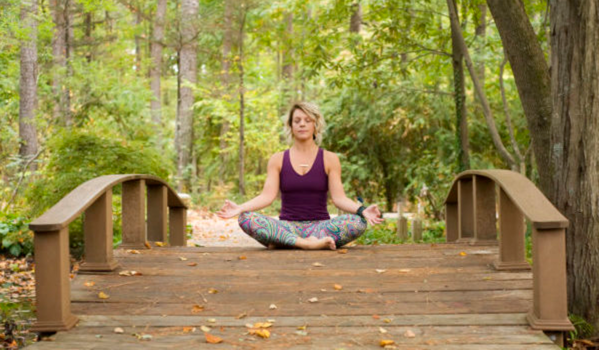Articles, In the Press, Megan Kearney, Yin, Restorative and Meditation, Yoga Medicine® News
How to Start a Daily Mindfulness Practice
Megan Kearney for Yoga Digest shares why mindfulness is so key, a story about living in the moment, and how to cultivate a mindfulness practice of your own.

Stress, Struggle & Strawberries: Inquire Within To Be Mindful With All
Eat the strawberry. That’s the thought that sticks out in my mind about that moment. And how tender it was, when just a couple hours before I was a hot-headed raging mom-preneur mess, juggling multiple hats and two kids under three.
The strawberry was part of a story that Buddhist monk (and fellow mom) Pema Chodron retells in her book The Wisdom of No Escape. The story begins with a woman chased by tigers to a cliff. In an effort to escape, the woman scrambles down a vine; but as she is descending, she looks down to see more tigers at the foot of the vine. “Tigers above, tigers below” she writes. At another glance to the top, the woman notices a mouse who is steadily chewing through the vine. Suddenly, she sees something large and red in her peripheral vision. It’s a strawberry. And in that “damned if you do, damned if you don’t moment,” she stops and eats the strawberry.
Tigers Above, Tigers Below
I read this at a time when I was struggling as a wife, stay-at-home mom, with my identity as a person and the desire to make an impact in my community. My fear was that I was doing everything so badly in the struggle that the impact was going to be a negative one if I didn’t pull myself together. Tigers above. Tigers below.
In every moment, I was pushing, striving and working. There was no present. I had ditched my steady meditation practice three years prior upon my daughter’s birth; and now, time on my beautiful silk cushion was a stomach tossing, better-things-to-do, threatening thought. Even when I could sit, I couldn’t keep my eyes closed or even softly opened. My eyes just sprung open every chance. Like a deer in headlights, my gaze seemed fixated on my future.
Meditation & Mindfulness
At the suggestion of my Ayurvedic coach, I changed some things in my diet and started a practice of yoga nidra. Yoga nidra is a form of formal meditation and open monitoring. Often called “yogic sleep,” it is considered one of the “deepest possible states of relaxation while still maintaining full consciousness.” I tried a guided version daily and for the first couple of weeks, I cried each time as I wrote back to my teacher, “I am falling asleep!!” To which she replied, “Be patient. You must need it.”
So I kept on. I also started reading anything by meditation guru and MBSR founder Jon Kabat-Zinn. I started to realize that I need to apply mindfulness daily. Like sprinkles to a cake – softly and spread throughout. And it worked.
The reason? There are formal meditation practices that consist of focused awareness or open monitoring, yoga and mindful walking, and even self-inquiry work. But then there are also informal practices: simple daily activities like savoring your meals, being creative, working physically, sending gratitude or well wishes to yourself or others. Or, in my case, being so present with your young child’s bath that your senses seem to heighten and the world slows down. You can feel their soft skin and locks and smell the shampoo so clearly, even ten years later.
Mindfulness is a daily practice. It takes intention and attention. It takes the right attitude — one of trust, patience and acceptance. One needs to be less critical of themselves and to let go. Let go of the desires to be right, to be perfect, to be anything but in the moment. To focus less on the tigers above and the tigers below. And just eat the strawberry.
Tips for a Mindful Day-to-day
- Self-care: I create a routine around my care in the morning and/or at night — scrubs, oils, whatever works for you! I even light candles and make it super special.
- Early rise: I wake before everyone to practice meditation, read or write.
- Love notes: I leave Post-it notes around for my family, especially when I am going away. I also try to give one handwritten note a week to a friend.
- Get outside: My husband and I walk the dogs together in the evening. It’s slow and we talk about everything or nothing at all.
- Smiling: It sounds easy, but we can get busy or focused and FORGET! If you work alone, you can even place a pencil between your teeth and force a smile. Research shows that it’s the only thing you can fake that your brain doesn’t know about.
- Random act: Once a month, I do something unexpected for the person in line behind me – whether at a coffee shop or grocery store.
Read on YogaDigest here.












